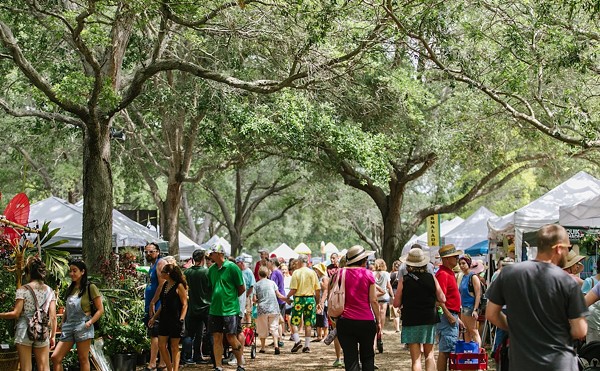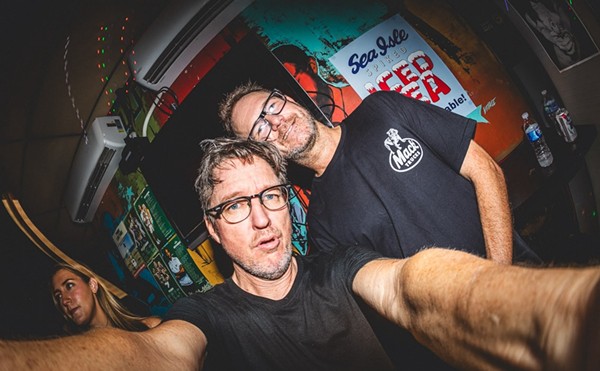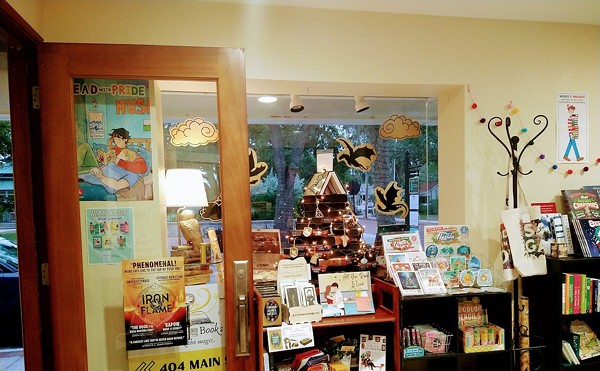Not only because there was nothing for this phoenix to do but rise, architect Stanley Saitowitz’s building doesn’t just look good; it feels fantastic. (Though his office is based in San Francisco, the warmly intelligent architect seems to have intuited exactly what Tampa needed to recover. Whether landscape architect Thomas Balsley has brought as effective a cure to the surrounding Curtis Hixon Park is harder to tell yet.)
The building’s sleek, perforated metal-clad exterior is by now long familiar to drivers-by in downtown Tampa; happily, its insides are no less elegant. A study in white-on-white serenity, its vast lobby tells visitors all they need to know: relax, everything is going to be fine. In the crisp clarity of this institutional space, intersected by a white concrete staircase suggestive of a narrow but steadfast spine, doubt and disorder are banished. Design — in the form of spotless glass, white benches and filtered daylight — at last, heals.
Though Matisse headlines (more on that below), executive director Todd Smith and his staff have scored their biggest success by composing specific opportunities for thoughtful viewership throughout the museum. The new approach taken to organizing the museum’s antiquities collection exemplifies this effect: while the old museum displayed ancient Greek and Roman artifacts chronologically, crowded into vast glass cases built into its walls, the new space presents clusters of objects, arranged in thematic nodes and smaller vitrines. In the airy lightness of the dedicated gallery, the objects seem finally to come to life — a vase commemorating the Pan-Athenaic Olympic games (a classical “souvenir,” if you will) or a small vessel for baby food conjure up images of historical lives at once different from and similar to our own.
The deepest stirrings of canonical satisfaction — at last, this is what our art museum should be — arise from what awaits visitors at the top of the central staircase. Here, a gallery containing four modernist paintings — canvases by Helen Frankenthaler, Frank Stella, Ellsworth Kelly and Sam Francis — invites us into the kind of hushed contemplation of large, abstract works that has become the quintessence of museum experience; on the gallery’s exterior wall, draped, vividly colorful canvases by Sam Gilliam seem both to play on and to affirm this variety of visual pleasure. In this space, the building powerfully achieves the sacred-space-for-looking effect that is so seductive and satisfying —a nd, I believe, in the context of our cultural trauma, healing — about museum-going. (Needless to say, Saturday’s opening-day hoopla will hardly offer opportunities for hushed reflection, but try returning on a midweek morning to appreciate the gallery’s temple-like earnestness.)
Elsewhere, visual pleasures are alternately witty, cerebral, erotic and technical. Garry Winogrand’s portfolio Women are Beautiful offers little evidence to the contrary (think of the exhibit as a paean to the braless ’60s). Maria Friberg’s nearby three-channel video of lithe men slowly slithering out of a disheveled bed offers a witty rejoinder, Smith hopes. (It does and — through its uncanny resonances of birthing — also chatters with the adjacent antiquities, organized around themes of life and death.) An exhibit of contemporary works drawn from the Miami-based Martin Z. Margulies Foundation collection will perhaps trigger some head-scratching — not in a bad way — along with oh’s and ah’s. (Do-Ho Suh’s life-sized mesh reconstruction of a bathroom — down to a flaccid showerhead dangling from the fabric wall — is one of the “wow” pieces, but far from the only one.) Offering unconventional views of urban life, the small showcase reinforces the museum’s implicit proclamation that it is an institution for a city, even if for one that’s still finding its identity.
As for Matisse, visitors will get a generous exposure to the artist’s treatment of certain themes — e.g., the female nude, portraits — and the manner in which he pursued experimentation within the media of printmaking. There are no famed paintings in sight; the show offers a thought-provoking and unexpected portrait of the artist as worker and thinker rather than a celebration of the idea of “Matisse” that has come to dominate popular understanding of modern art. That said, Matisse still functions here as a kind of paternal anchor for the museum’s inaugural exhibitions and its play for institutional authority. Though his lines appear soft and curvaceous — in, for instance, the female faces in a series of dramatic aquatints lining one gallery wall — they are tasked with providing as firm a foundation for TMA’s nascent cultural capital as its concrete frame.
Matisse once remarked that he wanted his art to function like a comfortable armchair for the tired businessman. At the suddenly smooth end of a rather bumpy ride for one museum and its city, that sounds like a welcome invitation.
















